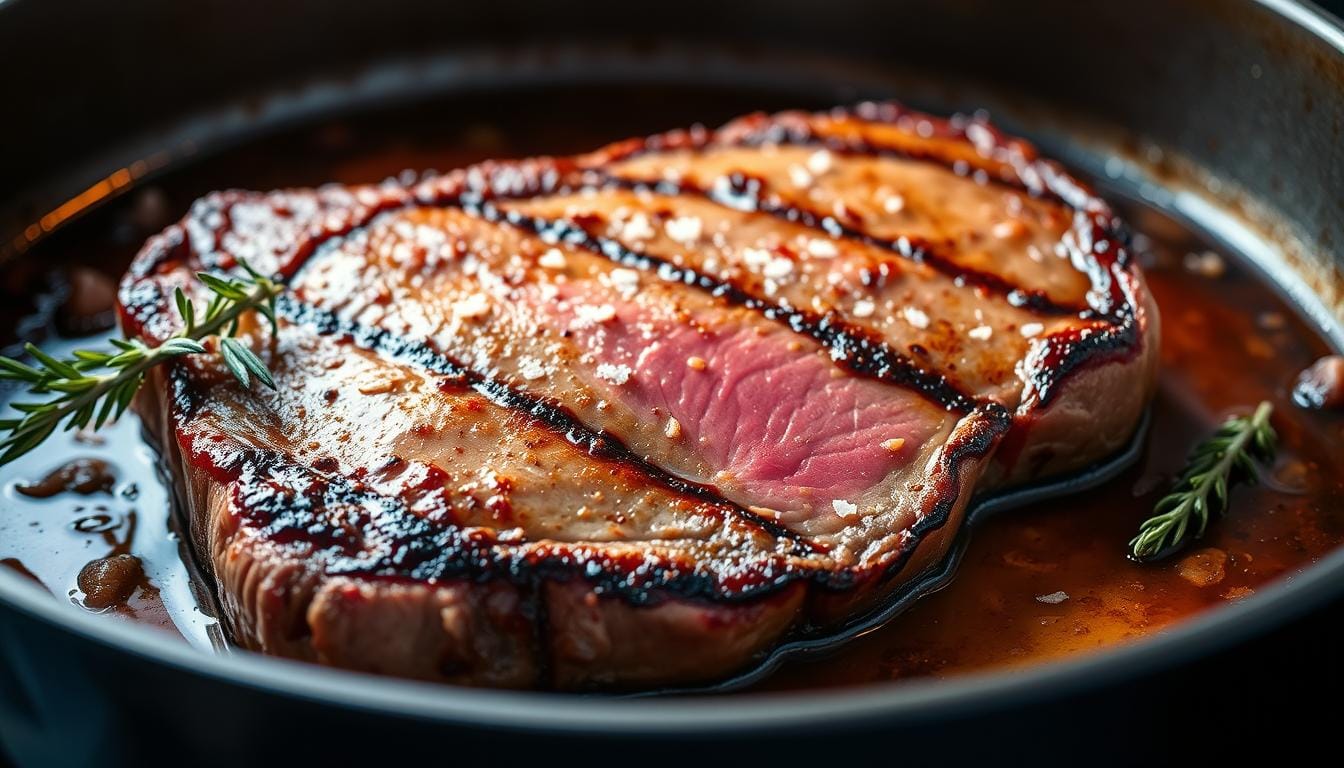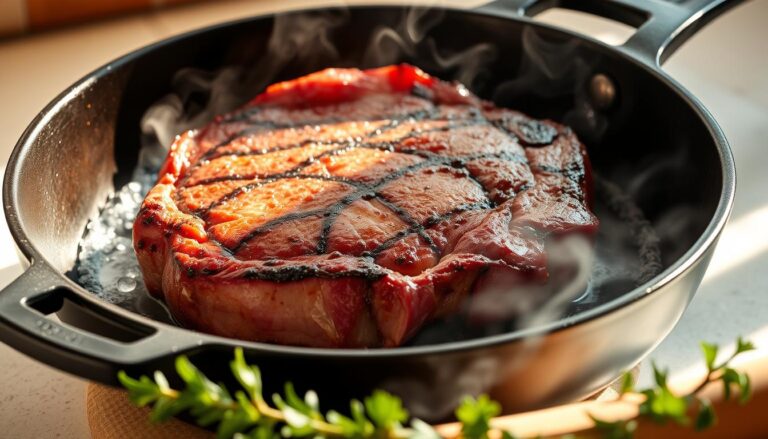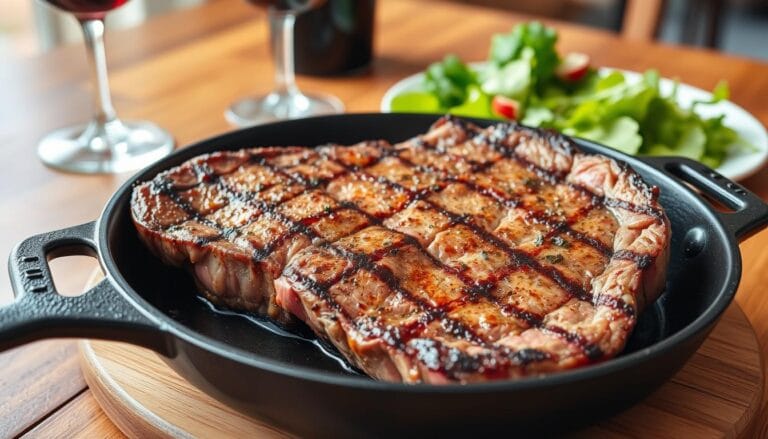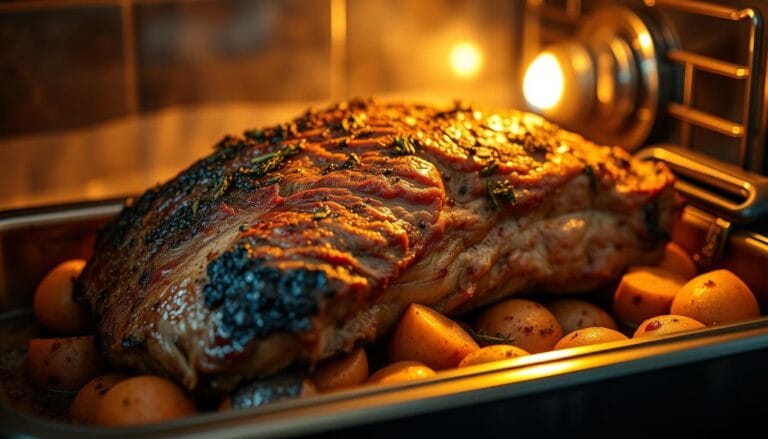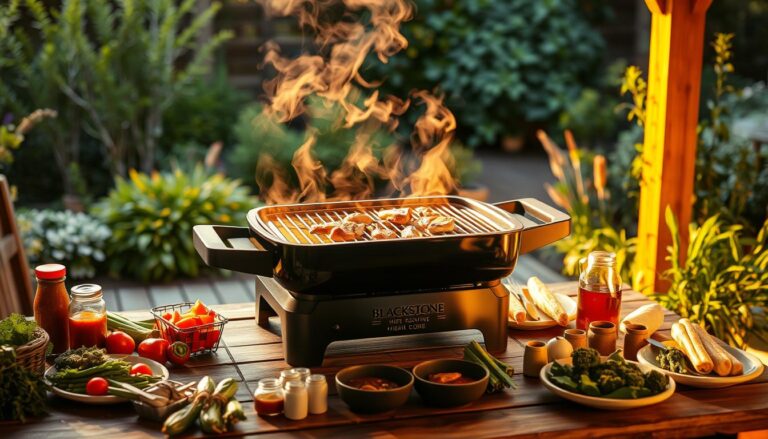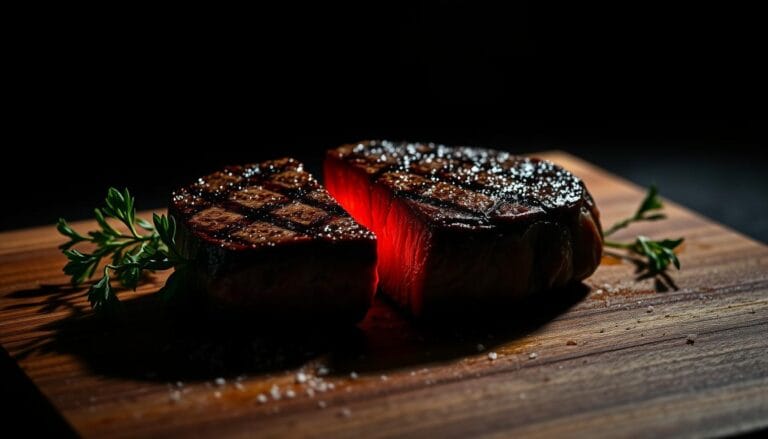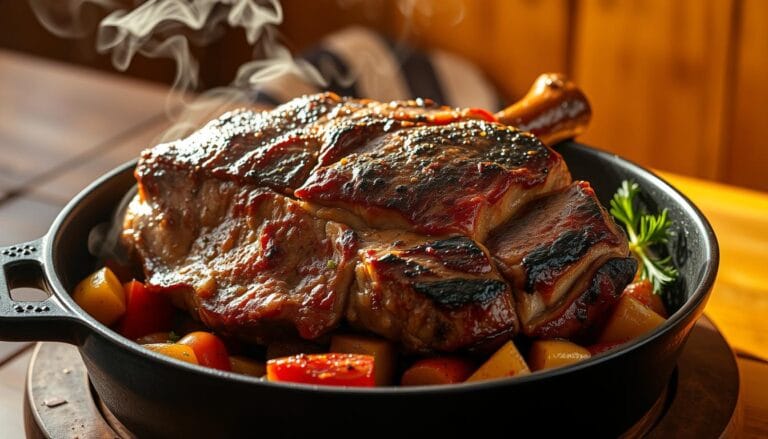The best New York Strip steak in Oven
Table of Contents
the Juicy New York Strip steak in Oven
Have you ever stood at the meat counter, looking at the New York strip? You imagine its rich, buttery taste. But then, you worry about it turning dry. What if it turns out dry? What if you mess up an expensive cut?
I’ve been there too. I’ve had chewy steaks and wondered why they weren’t like restaurant food. But here’s a secret: your oven is the most reliable tool you’re not using enough.
Imagine a steak with a crispy crust and a tender center. Its juices pool on the plate. No grill flare-ups or guessing games. Just consistent perfection, even on busy nights.
This method isn’t just for chefs. It’s for anyone who wants restaurant-quality meals without stress. You’ll learn about temperature control, why a simple seasoning blend works, and how to lock in flavor easily.
By the end of this guide, you’ll be able to serve steaks that are as good as those in high-end steakhouses. Ready to make your kitchen a culinary hotspot? Let’s get started.
Key Takeaways
- Achieve juicy, evenly cooked steaks using your oven’s steady heat
- Skip complicated techniques—this method requires minimal prep time
- Create a flavorful crust with a quick post-oven sear
- Use affordable tools already in your kitchen
- Adapt cooking times for different thicknesses effortlessly
- Pair perfectly with roasted veggies or mashed potatoes
What is a New York Strip Steak?
The New York strip is a key part of American steakhouse tradition. It’s known for its rich flavor and tender texture. This makes it a hit with both home cooks and chefs.
Origin of the New York Strip
The New York strip comes from 19th-century Manhattan steakhouses. It’s said to have been famous at Delmonico’s Restaurant. There, thick-cut steaks were served to the wealthy.
Originally called the “Delmonico steak,” it became known as the New York strip nationwide. Today, it’s also called the “Kansas City strip” or “club steak.” But the New York name is the most well-known.
Characteristics of a New York Strip
This steak is easy to spot because of its unique features:
- Marbling: It has moderate fat streaks that melt during cooking, making it juicy
- Texture: It’s firm but tender, unlike softer cuts like filet mignon
- Shape: It’s a long, rectangular cut from the short loin with a fat cap on one edge
The New York strip has a goldilocks balance of marbling. It’s not too fatty like a ribeye or too lean like a sirloin. This makes it great for oven cooking, where the heat cooks the fat evenly.
Why Choose New York Strip?
Here are three reasons to choose this cut for your next oven recipe:
- Forgiving texture: It stays moist even when cooked at high heat
- Versatility: It goes well with simple seasonings or bold marinades
- Consistent results: Its even thickness ensures it cooks evenly in the oven
Compared to other cuts, the New York strip offers great value. It has more beefy flavor than a top sirloin. Its structure also makes it easier to control the temperature, which is key for oven cooking.
Why Cooking in the Oven is Ideal
Learning to cook a New York strip in the oven lets you get steakhouse-quality results easily. It avoids uneven searing and cuts down on cooking time. This makes it great for both weeknights and special events. Let’s look at why it’s better than stovetop frying.
Consistent Temperature Control
Ovens give steady, even heat that stovetops can’t match. Unlike pans with hot spots, your steak cooks evenly. This is key for thicker cuts, which need gentle heat to avoid burning the outside before the inside is cooked right.
Try the reverse sear method for precision. Cook the steak at 275°F first, then sear it quickly. This method ensures a perfect medium-rare inside and a crispy outside. No need to cut into the meat to check if it’s done!
Easy Clean-Up
Goodbye to grease splatters on your stovetop. Baking your New York strip in the oven keeps messes to a single sheet pan or oven-safe skillet. Just line the pan with foil or parchment paper, and cleaning up takes less than a minute.
| Factor | Oven | Stovetop |
|---|---|---|
| Splatter Risk | Low | High |
| Grease Spread | Contained | Widespread |
| Post-Cooking Mess | 1 Pan | Multiple Surfaces |
Versatile Cooking Methods
Your oven can do it all, from roasting to broiling. Want a smoky flavor? Use a cast-iron skillet. Prefer a buttery finish? Baste with herbs and garlic during the last few minutes. The choices are endless.
Broiling gives a caramelized crust in under 5 minutes. Slow-roasting ensures tender results every time. You can even mix techniques—sear first, then bake—to keep juices in without constant stove watching.
Essential Tools for Cooking New York Strip
To cook a New York strip in oven like a pro, you need the right tools. The cut itself is full of flavor. But these three tools make sure your steak is cooked just right every time.
Baking Sheet and Rack
A sturdy baking sheet, like Nordic Ware’s Natural Aluminum Commercial Baker, is perfect. Pair it with an oven-safe rack. This setup lets hot air circulate around your steak evenly.
No soggy bottoms or uneven browning. Your steak will get a beautiful caramelization on all sides.
Instant-Read Thermometer
Don’t rely on guesswork for doneness. The ThermoPro TP19H thermometer gives exact internal readings in seconds. Just insert it into the thickest part of your steak.
Aim for 130°F for that perfect medium-rare. This way, you avoid undercooking or drying out the meat.
Aluminum Foil
After cooking, let your steak rest. Cover it loosely with foil for 8-10 minutes. This keeps the juices in and lets the heat finish cooking it.
Use Reynolds Wrap Heavy Duty for the best heat retention without sticking.
Selecting the Perfect New York Strip
Choosing the right New York Strip steak is key to a tender and flavorful oven-cooked meal. Look at three important things: thickness, marbling, and where the steak comes from. These factors affect how juicy and tasty the steak will be.
Factors to Consider
First, check the steak’s thickness. A 1.5 to 2-inch cut is best for oven cooking. It keeps the meat moist and cooks evenly. Thinner steaks might dry out, though.
Then, examine the marbling—the white fat in the meat. A higher marbling score, like USDA Prime, means the steak will be more tender and flavorful. Aim for even fat distribution, not big clumps.
- Ideal thickness: 1.5–2 inches
- Marbling score: Moderate to abundant
- Color: Bright red with creamy fat
USDA Grading and Quality
USDA grades show the steak’s marbling and quality. Here’s what you need to know:
| Grade | Marbling Level | Best For |
|---|---|---|
| Prime | Abundant | High-heat oven cooking |
| Choice | Moderate | Everyday meals |
| Select | Minimal | Marinated dishes |
Prime-grade steaks are the best for oven cooking because of their fat content. Choice grades are a good balance of quality and price.
Grass-Fed vs. Grain-Fed
Your choice between grass-fed and grain-fed steaks changes the flavor and texture:
| Type | Flavor Profile | Texture | Price |
|---|---|---|---|
| Grass-Fed | Earthy, leaner | Firmer | Higher |
| Grain-Fed | Buttery, rich | Softer | Lower |
Grass-fed steaks have a strong, natural taste. Grain-fed steaks are richer and softer. Pair grass-fed cuts with bold seasonings for a deeper flavor.
Preparing Your New York Strip
Before cooking your steak, make sure it’s ready for the oven. This means seasoning, marinating, and adjusting the temperature. These steps turn a simple cut into a restaurant-quality meal in your kitchen. Let’s explore how to season, marinate, and adjust the temperature for perfect results.
The Importance of Seasoning
Dry brining is key for a flavorful crust. Sprinkle coarse salt on both sides of the steak 1-2 hours before cooking. This method draws moisture to the surface, dissolves the salt, and seasons the meat deeply.
Use coarse salt, not fine table salt, for even distribution. Mix kosher salt with cracked black pepper just before cooking. Pro tip: Add a pinch of garlic powder or smoked paprika for extra flavor.
Techniques for Marinating
Soy-based marinades add a rich umami flavor without overpowering the beef. Mix soy sauce, olive oil, minced garlic, and a bit of honey for a savory-sweet glaze. Let the steak marinate for 30 minutes to 2 hours to avoid toughness.
Acidic marinades, like lemon juice or vinegar, are best for tenderizing tougher cuts. New York Strip is already tender, so use acidic ingredients sparingly. Too much acid can make the meat mushy.
Bringing Steak to Room Temperature
Cold steak cooks unevenly, leading to overcooked edges. Let your New York Strip sit uncovered on the counter for 30-45 minutes before cooking. This ensures even cooking from edge to edge.
Use this time to preheat your oven or prepare side dishes. Never leave raw meat at room temperature for more than 2 hours to avoid bacterial growth.
Cooking Methods: Oven vs. Grill
Cooking your New York Strip: oven precision meets grill flavor in this showdown. Both techniques deliver delicious results. Understanding their strengths helps you pick the right approach for your meal. Let’s break down what makes each method unique and how to maximize their potential.
Pros and Cons of Each Method
Oven cooking offers unmatched temperature control, making it ideal for thick cuts. You’ll avoid flare-ups and achieve even doneness from edge to center. Clean-up is simpler, and you can multitask while it cooks. But, you’ll miss the charred crust and smoky aroma that grilling provides.
Grilling shines with its bold, smoky flavor and faster cooking time. It’s perfect for thinner steaks or outdoor gatherings. But it demands constant attention to prevent overcooking, and weather can disrupt your plans. For a hybrid approach, try finishing an oven-cooked steak on the stove with a cast-iron skillet to add a crispy crust.
Flavor Profiles Compared
Grill enthusiasts love the robust, charred notes from open flames and wood chips. This method enhances the steak’s natural richness with a touch of smokiness. Oven-roasted strips, on the other hand, focus on juiciness and tenderness, locking in moisture for a buttery texture. Adding herbs or garlic butter during baking can elevate these flavors without overpowering the meat.
When to Choose Each Method
Use the oven when cooking thicker cuts (1.5 inches or more) or meal prepping multiple steaks. It’s also a lifesaver during rainy days or busy weeknights. Fire up the grill for social events, thinner cuts, or when craving that classic barbecue taste. For a restaurant-quality sear, combine both methods: bake to your desired doneness, then sear on the stove for 60 seconds per side.
| Factor | Oven | Grill |
|---|---|---|
| Temperature Control | Precise, even heat | Variable, depends on fire |
| Flavor Intensity | Mild, meat-forward | Smoky, charred |
| Best For | Thick cuts, indoor cooking | Quick cooks, outdoor events |
| Skill Level | Beginner-friendly | Requires practice |
Whether you’re learning how to grill strip steak for a summer BBQ or mastering how to cook strip steak on stove for a weeknight dinner, each method has its place. Match your choice to the occasion, and don’t hesitate to experiment with hybrid techniques for the best of both worlds.
Step-by-Step Guide to Cooking in the Oven
Learning to cook New York strip steak in the oven is easy. It makes your steak juicy and delicious. Just follow these simple steps to make a meal that tastes like it came from a restaurant.
Preheating the Oven
First, set your oven to 400°F. This temperature is perfect for searing and cooking the steak gently. Let it preheat fully for about 15 minutes. This ensures the heat is even.
If you’re using a cast iron skillet, put it in the oven while it’s preheating. This helps get a great steakhouse sear.
Searing the Steak
Heat a cast iron skillet on the stove over medium-high for 2 minutes. Dry your 1.5-inch steak with paper towels. Then, put it in the skillet.
Sear the steak for 2-3 minutes on each side. Don’t move the steak during searing. This step adds flavor and texture.
Cooking and Monitoring Internal Temperature
Put the skillet in the oven right after searing. Use an instant-read thermometer to check the steak’s internal temperature. Cook until it reaches:
- 125°F for rare (8-10 minutes)
- 135°F for medium-rare (10-12 minutes)
- 145°F for medium (12-14 minutes)
Take the steak out of the oven 5°F before your target temperature. This allows the heat to finish cooking it. Let it rest for 5-10 minutes before slicing. This helps keep the juices inside.
Important Temperature Guidelines
Mastering temperature control is key to making your New York strip in the oven truly exceptional. Whether you like your steak rare or well-done, knowing these guidelines ensures it cooks evenly. This helps keep its juices inside.
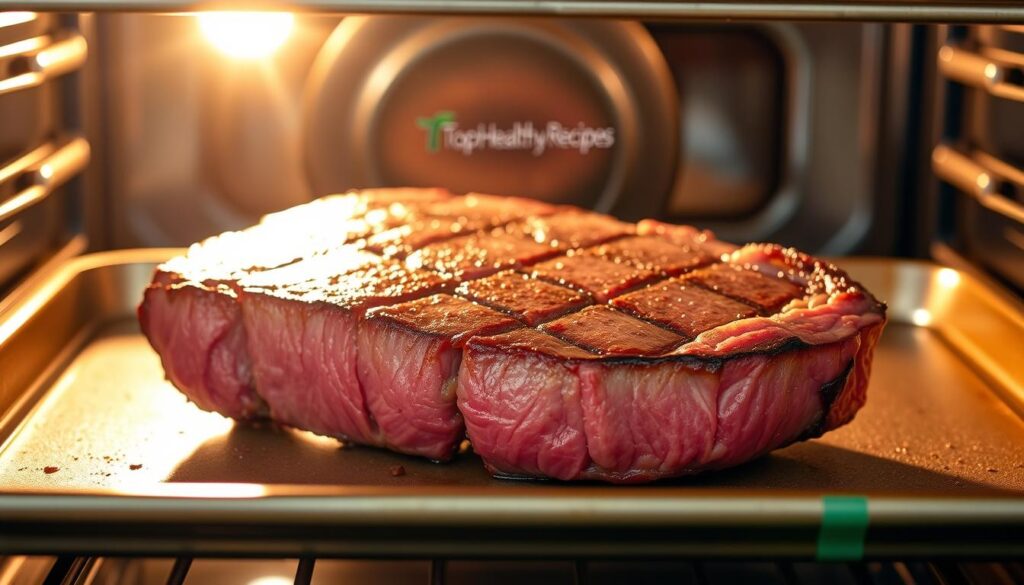
Rare to Well Done – What to Know
The USDA says to cook steak to at least 145°F (63°C) for safety. But chefs often recommend lower temperatures for high-quality cuts like New York strip. Here’s a quick guide:
| Doneness | USDA Temp | Chef Preferred Temp |
|---|---|---|
| Rare | 125°F | 120-125°F |
| Medium Rare | 135°F | 130-135°F |
| Medium | 145°F | 140-145°F |
For oven cooking, take the steak out 5°F before your target temperature. Why? Carryover cooking will increase the internal temperature as it rests.
How to Check Internal Temperature
Use an instant-read thermometer in the thickest part of the steak. Make sure not to touch bones or fat pockets for accurate readings. If you don’t have a thermometer, press the meat gently:
- Rare: Feels like the base of your thumb when relaxed
- Medium: Resembles the firmness of a clenched palm
Resting Time After Cooking
Let your oven-baked New York strip rest for 5-10 minutes under loose foil. This helps the juices spread out, making the steak juicy. During this time, the internal temperature can rise up to 10°F due to residual heat.
“Resting isn’t optional – it’s the final stage of cooking.”
For thicker cuts (1.5+ inches), rest for 15 minutes. Combine this with proper seasoning for top-notch steak every time.
Enhancing Flavor with Add-Ins
Turn your New York strip steak into a masterpiece with creative add-ins. These simple additions pack a big punch, letting you tailor your meal. They enhance the steak’s natural flavor without overpowering it.
Fresh Herbs for Aromatic Depth
Rosemary and thyme are perfect for steak, even when baked. Place whole sprigs on the baking sheet. The heat releases oils that add depth to the meat. For a stronger taste, chop the herbs finely and rub them on the steak.
Garlic Butter That Melts Perfection
Make a compound butter while your steak rests. Mix softened butter with minced garlic, parsley, and smoked paprika. Spread a slice of this butter on your steak when it’s done. It melts into a sauce that sticks to every bite.
Marinades & Rubs Made Simple
Dry rubs add flavor without a lot of prep. Try this coffee-based blend:
- 2 tbsp finely ground coffee
- 1 tbsp brown sugar
- 1 tsp chili powder
- 1/2 tsp sea salt
| Add-In Type | Key Ingredients | Prep Time | Best For |
|---|---|---|---|
| Compound Butter | Garlic, herbs, citrus zest | 5 mins | Finishing sauce |
| Wet Marinade | Soy sauce, honey, lime juice | 30+ mins | Tenderizing |
| Dry Rub | Spices, coffee, brown sugar | 2 mins | Flavor crust |
For quick marinades, use a 3:1 oil to acid ratio. Marinate for at least 30 minutes. But don’t marinate for more than 4 hours to avoid mushy texture.
Common Mistakes to Avoid
Steering clear of a few common errors can make your oven-cooked New York Strip steak truly memorable. Whether it’s your first time or your hundredth, mistakes like poking the steak or choosing a thin cut can ruin your dish. Let’s explore the most common mistakes and how to avoid them for a perfect meal.
Overcooking the Steak
The biggest mistake is overcooking your NY strip. Thin cuts (less than 1 inch thick) dry out fast, while thicker steaks might not cook evenly. Always use an instant-read thermometer to check the temperature. Take the steak out of the oven 5°F before your desired temperature. It will finish cooking as it rests.
Don’t press the steak with tongs or slice it too soon. This can make it tough and lose juices. If unsure, it’s better to undercook it a bit. You can always put it back in the oven for a minute.
Neglecting to Rest the Meat
Not letting the meat rest is like throwing away half its flavor. Resting allows juices to spread evenly, keeping the steak moist. Cover the cooked steak with foil and wait at least 5–7 minutes before slicing.
Don’t peek or poke during this time. Cutting too soon lets steam out, making the steak dry. Use this time to prepare sides or plate your dish.
Choosing the Wrong Cut
Not all NY strips are the same. Choose steaks with even marbling and a bright red color. Avoid very lean cuts, as fat adds flavor and moisture. Opt for 1.25–1.5 inches thick steaks to prevent drying and ensure good searing.
Thin cuts, often found in stores, cook too quickly, making it hard to control temperature. If you only find thin steaks, reduce cooking time by 2–3 minutes and watch closely. Better yet, ask your butcher for a custom-cut piece.
Pairing Sides with Your New York Strip
A perfectly cooked New York Strip needs sides that enhance its flavor. Whether it’s for a dinner party or a weeknight meal, the right sides make your oven-baked steak complete. Let’s look at classic choices, wine pairings, and bold flavors that go well with your main dish.
Classic Side Dishes
Traditional pairings aim to balance textures and add savory flavors. Here are some favorites:
- Loaded baked potatoes: Their crispy skins, melted cheese, and bacon bits add richness without overpowering the steak.
- Garlic mashed potatoes: These are creamy and aromatic, making them a great match for the steak’s juiciness.
- Sautéed asparagus: It offers a light, earthy contrast to the steak’s boldness.
Wine Pairings
Red wines with structured tannins pair well with the steak’s fat. Here are some top picks:
- Cabernet Sauvignon: Its dark fruit flavors and oak undertones complement the steak’s charred crust.
- Malbec: It adds depth with plum and blackberry notes.
- Zinfandel: Its peppery finish balances the meat’s natural sweetness.
Unique Flavor Combos
For those who like to try new things, here are some unique matches:
- Blue cheese & candied walnuts: The tangy cheese and sweet walnuts offer a surprising combination.
- Roasted cherry tomatoes with thyme: Their acidity refreshes the palate between bites.
- Mushroom risotto: It brings earthy umami to the dish.
Don’t be afraid to mix things up. A spicy chimichurri or honey-glazed carrots can take your New York Strip in the oven to the next level.
Storing Leftovers Safely
Keeping your New York Strip fresh is key to enjoying every bite. We’ll show you how to keep it tasty and safe for days.
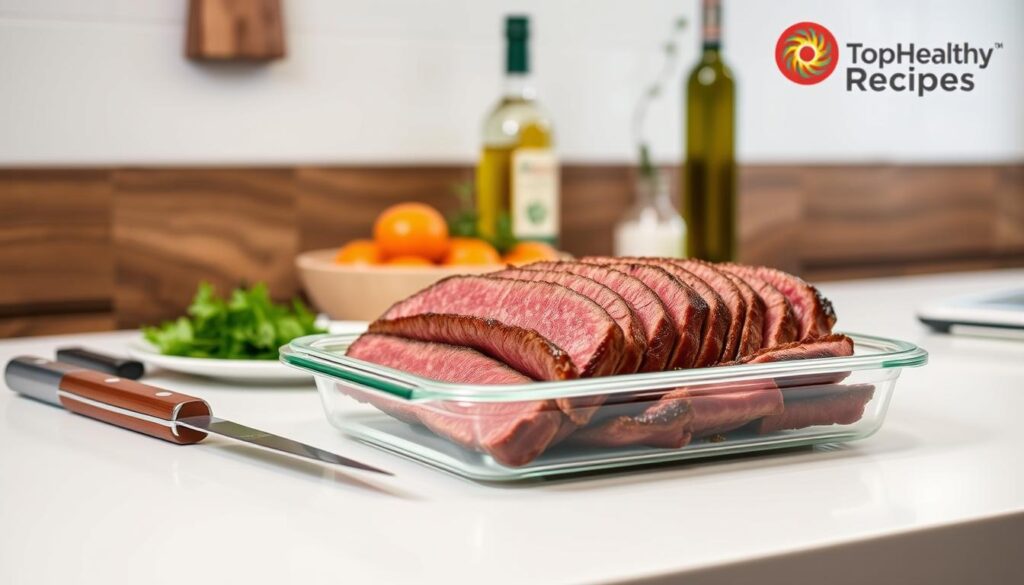
Refrigeration Tips
Cool your steak to room temperature in 2 hours. Wrap it tightly in plastic or foil, or use an airtight container. The USDA says to refrigerate cooked beef for 3-4 days maximum at 40°F or below.
For the best taste, put it on the middle shelf. Door temperatures are too changeable.
Freezing for Later Use
Freeze leftovers within 3 days for the best taste. Use vacuum-sealed bags or double-wrap in heavy-duty foil. Label packages with dates.
Frozen New York Strip stays safe forever but tastes best in 2-3 months. Thaw it overnight in the fridge before reheating.
Reheating Methods
Avoid microwaves to keep your steak juicy. Try these methods instead:
- Sous vide: Set to 130°F (for medium-rare) and immerse sealed steak for 45 minutes
- Oven: Place on a rack at 250°F until internal temp reaches 120°F (about 20 minutes)
Always check the steak’s temperature with a meat thermometer. It should be 165°F for safety.
| Method | Duration | Key Tip |
|---|---|---|
| Refrigeration | 3-4 days | Use shallow containers |
| Freezing | 2-3 months | Remove air from packaging |
| Reheating | 20-45 mins | Add butter while reheating |
Recipes Featuring New York Strip
Take your cooking to the next level with these delicious recipes. They show how versatile the New York Strip is. Whether you like simple dishes or bold flavors, there’s something here for you.
Simple Oven-Baked New York Strip
This foolproof method delivers restaurant-quality results every time:
- Preheat oven to 400°F (204°C)
- Season steak generously with kosher salt and black pepper
- Sear in a smoking-hot cast iron skillet for 2 minutes per side
- Transfer skillet to oven for 6-8 minutes
- Remove when internal temperature reaches 130°F (54°C) for medium-rare
Let the steak rest 5 minutes before slicing. The high heat creates a perfect crust while keeping the center juicy.
Creative Recipes to Try
Try something new with these bold flavors:
- Korean BBQ-Style: Marinate in gochujang, soy sauce, and sesame oil
- Espresso Crusted: Rub with ground coffee, brown sugar, and smoked paprika
- Balsamic Glazed: Finish with reduced balsamic vinegar and fresh figs
For a unique twist, stuff butterflied strips with kimchi and mozzarella before roasting. It’s a flavor explosion!
Expert Chef Recommendations
Gordon Ramsay’s butter-basting technique is a game-changer:
“Always baste your steak with foaming butter, garlic, and herbs during the last 2 minutes of cooking. It creates an incredible flavor layer.”
Top chefs also recommend:
- Dry-brining steaks 24 hours before cooking
- Using compound butter with roasted shallots
- Pairing with unexpected sides like truffle mashed cauliflower
Cooking for Special Occasions
Make any gathering special with a tender, oven-roasted New York strip steak. This cut is perfect for events where taste and looks are key. It brings a restaurant-quality meal right to your kitchen. Whether it’s a big celebration or a dinner party, these tips will make your meal the star of the show.
Ideal Occasions for New York Strip
A New York strip cooked in the oven is great for:
- Anniversary dinners: Pair with roasted veggies and a bold red wine.
- Holiday feasts: Serve as the main dish with mashed potatoes and seasonal sides.
- Date nights: Add truffle salt or a red wine reduction for a fancy touch.
Tips for Serving Guests
Plan your meal prep well. Sear the steak 30 minutes before serving, then finish it in the oven. Use an instant-read thermometer to check for doneness. For plating:
- Slice against the grain for tenderness
- Drizzle with warm herb butter just before serving
- Garnish with fresh thyme or edible flowers
Try pairing your steak with garlic butter shrimp for a surf-and-turf delight.
Creating a Gourmet Experience at Home
Enhance your New York strip in the oven with these expert tips:
- Brush steaks with melted bone marrow during resting
- Serve on preheated stoneware to keep meat warm
- Add finishing salts like smoked sea salt or Himalayan pink salt
“Presentation is half the battle. Use white plates to make the sear marks pop, and layer textures with crispy onions or microgreens.”
Health Benefits of New York Strip
Eating a New York Strip steak is not just tasty. It’s also good for you. This steak is packed with nutrients. It helps you reach your health goals.
Nutritional Value Overview
An 8oz serving of cooked New York Strip has a good mix of nutrients. Here’s what you get in a typical portion:
| Nutrient | Amount | % Daily Value* |
|---|---|---|
| Protein | 52g | 104% |
| Iron | 4.5mg | 25% |
| Zinc | 8.7mg | 58% |
| Vitamin B12 | 4.2mcg | 175% |
*Based on 2,000-calorie diet
Protein and Iron Content
New York Strip is a complete protein source. It has all nine essential amino acids your body needs. The iron in this steak helps carry oxygen in your blood. Zinc boosts your immune system. Vitamin B12 is good for your nerves and energy.
Balancing Your Diet
To get the most benefits from cooking NY strip steak:
- Pair it with fiber-rich veggies like asparagus or Brussels sprouts
- Stick to 6-8oz portions
- Go for grass-fed options for more omega-3s
It’s important to eat this steak in moderation. Aim for 2-3 times a week. Balance it with lean proteins like chicken or fish on other days.
Conclusion: Enjoying Your Perfectly Cooked New York Strip
Learning to cook a new york strip in oven is easy. Start by picking USDA Prime cuts and use an instant-read thermometer. This way, your steak will stay juicy and full of flavor.
The oven’s heat is even, making it perfect for cooking steaks just right. You can go from rare to medium-well without any trouble.
Don’t be afraid to add your own twist. Try using rosemary-thyme blends or avocado oil for searing. Use Lodge cast iron skillets or ThermoPro thermometers to improve your cooking. And always let the meat rest before serving. This keeps it tender and juicy.
Recap of Key Points
Remember, patience is key. Make sure your steaks are at room temperature and season them well. Always check the internal temperature to ensure it’s cooked just right.
Pair your new york strip in oven with roasted veggies or garlic mashed potatoes. This makes for a well-rounded meal.
Encouragement to Experiment
Get creative with your recipes. Try smoked paprika rubs or compound butter with roasted garlic. Share your dishes on social media with #OvenStripSteak and inspire others.
Final Thoughts on Cooking in the Oven
Cooking a new york strip in oven is great for any occasion. It’s perfect for busy weeknights or special dinners. With a bit of practice, you’ll become a pro at making delicious steaks every time.
FAQ
What makes New York Strip ideal for oven cooking?
Can I use the oven for reverse-searing a New York Strip?
How do I prevent overcooking my New York Strip in the oven?
What’s the best way to season a New York Strip before oven cooking?
Should I grill or oven-cook my New York Strip?
How long does a 1.5-inch New York Strip take in a 400°F oven?
Can I cook frozen New York Strip in the oven?
What sides pair best with oven-cooked New York Strip?
How do I store and reheat leftover New York Strip?
Is New York Strip healthier than ribeye or filet mignon?
For more cooking tips, stay connected with us. We also recommend the cookbook Skinnytaste Simple: Easy, Healthy Recipes with 7 Ingredients or Fewer
For more Recipes about Steak ?
Did You try our recipe ?
There are no reviews yet. Be the first one to write one.
